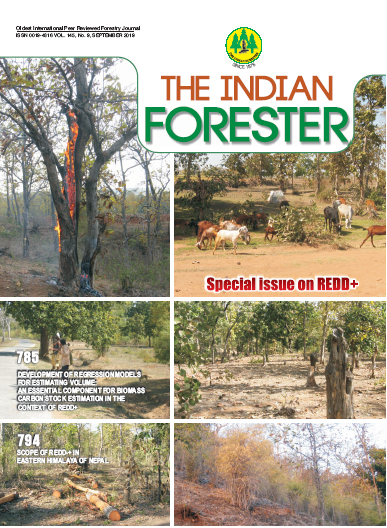Changing Narratives of the Drivers of Deforestation and Forest Degradation in the Himalayan Region
DOI:
https://doi.org/10.36808/if/2019/v145i9/148726Keywords:
No Keywords.Abstract
No Abstract.References
Angelsen A., Brockhaus M., Sunderlin W.D. and Verchot L. (2012). Analysing REDD+: Challenges and choices. Bogor, Indonesia: Center for International Forestry Research (CIFOR).
Baland J.M., Das S. and Mookerjee D. (2011). Forest Degradation in the Himalayas: Determinants and Policy Options. Working Paper No. 1116, University of Namur, Department of Economics.
Bhagwat T., Hess A., Horning N., Khaing T., Thein Z.M. and Aung K.M. (2017). Losing a jewel - Rapid declines in Myanmar's intact forests from 2002-2014. PLoS ONE, 12(5): e0176364. https://doi.org/10.1371/journal.pone.0176364
Bhattarai K., Conway D. and Yousef M. (2009). Determinants of deforestation in Nepal's Central Development Region. J. Envir. Management, 91 (2009) 471-488.
Blaikie P.M. and Sadeque Z.S. (2000). Policy in High Places: Environment and Development in the Himalayan Region, International Centre for Integrated Mountain Development, Kathmandu, Nepal.
Geist H.J. and Lambin E.F. (2002). Proximate causes and underlying driving forces of tropical deforestation. BioScience, 52:143-150.
Hosonuma N., Herold M., De Sy V., De Fries R., Brockhaus M., Verchot L., Angelsen A. and Romijn E. (2012). Environmental Research Letters, 7, 044009: 1-12.
Ives J.D. (1987). The theory of Himalayan environmental degradation: its validity and application challenged by recent research. Mountain Research and Development, 189-199pp.
Kissinger G., Herold M. and De Sy V. (2012). Drivers of Deforestation and Forest Degradation: A Synthesis Report for REDD+ Policymakers. Lexeme Consulting. Vancouver, Canada.
Myint A.A. (2017). Analysis of drivers of deforestation and forest degradation in Shan State and strategic options to address those. ICIMOD-GIZ REDD+ Project.
NITI Aayog (2018). Report of Working Group III. Shifting Cultivation: Towards a Transformational Approach. NITI Aayog. Delhi, India.
Paudel N.S., Khatri D.B., Khanal D.R. and Karki R. (2013). The context of REDD+ in Nepal: Drivers, agents and institutions. Occasional Paper 81. CIFOR, Bogor, Indonesia.
Qamer F.M., Shehzad K., Abbas S., Murthy M.S.R., Xi C., Gilani H. and Bajracharya B. (2015). Mapping Deforestation and Forest Degradation Patterns in Western Himalayas, Pakistan. Remote Sensing, 8, 385: 1-17.
Ranjan R. (2018). What drives forest degradation in the Central Himalayas? Understanding the feedback dynamics between participatory forest management institutions and the species composition of forests. Forest Policy and Economics, 95: 85-101
Rawat V.R.S., Rawat R.S. and Verma N. (2017). Drivers of Deforestation and Forest Degradation in Mizoram. Indian Council of Forestry Research and Education, Dehradun (India).
Rimal B., van Goor W., Trines E. and Karki G. (2014). Draft Report: Assessment of Drivers of Deforestation in Nepal. FCPF/REDD/S/QCBS-4: Analytical Study on Assessing the Value of Forests, the Political Economy of Land Use and the Carbon Emissions from the Drivers of DD. Face the Future (the Netherlands) for the REDD-Forestry and Climate Change Cell, Ministry of Forests and Soil Conservation, Kathmandu, Nepal.
Sadeq M.A. (2015). Deforestation and its Natural effect on Environment of Afghanistan. Ritsmeikan Asia Pacific University. Beppu, Japan.
Shah S.W.A. (2012). Political Reforms in the Federally Administered Tribal Areas of Pakistan (FATA): Will It End the Current Militancy? SAI 64: 1617-5069.
Treue T., Springate-Baginski O. and Htun K. (2016). Legally and Illegally Logged out: Extentand Drivers of Deforestation & Forest Degradation in Myanmar. EcoDev/ALARM.
Downloads
Downloads
Published
How to Cite
Issue
Section
License
Unless otherwise stated, copyright or similar rights in all materials presented on the site, including graphical images, are owned by Indian Forester.





